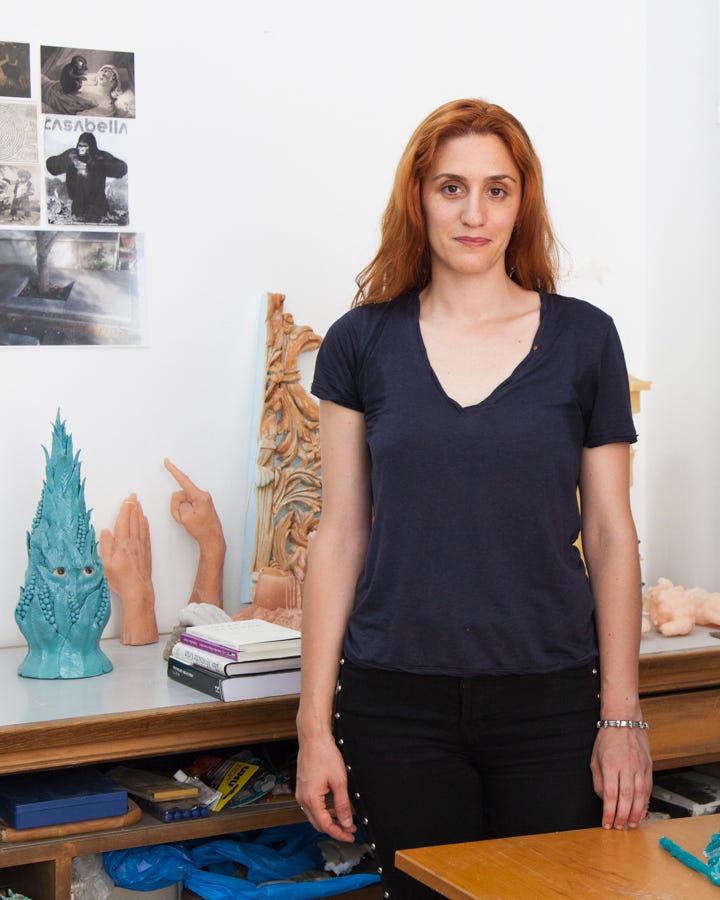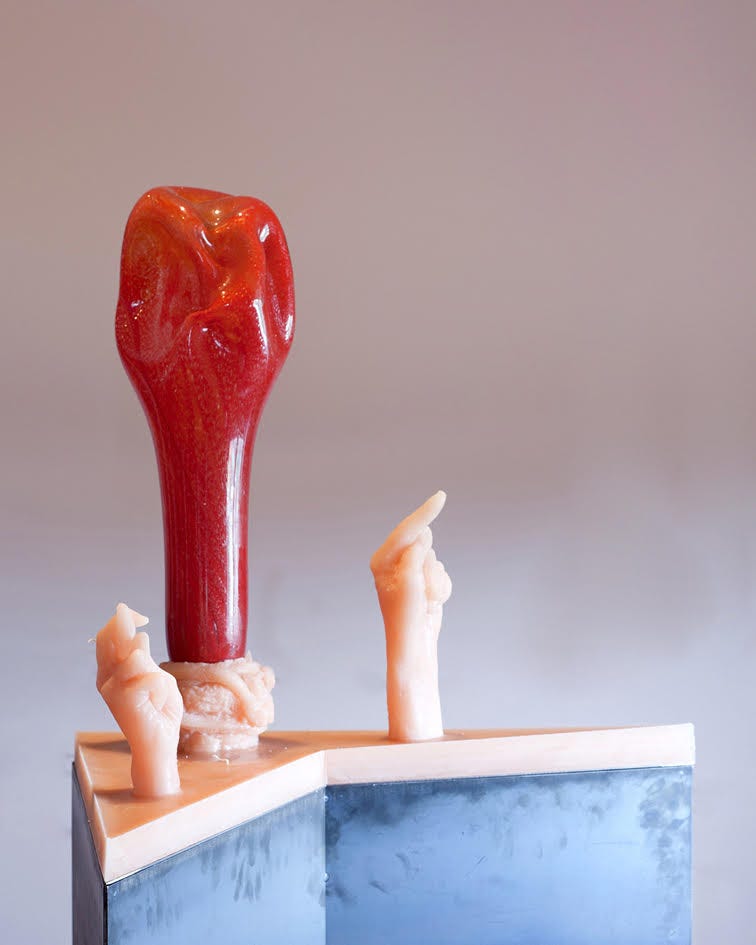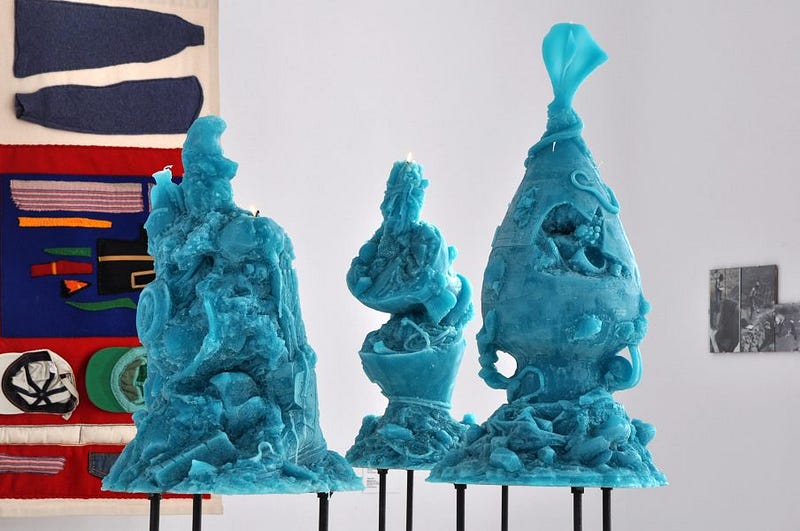12.09.2019
Malvina Panagiotidi’s Living Memories and Haunted Forms
Εικαστικες Τεχνες
Γλώσσα πρωτότυπου κειμένου: Αγγλικά

In Malvina Panagiotidi’s basement studio, pots sitting on top of small electric burners are filled with nameless liquids, slowly boiling. If you squint your eyes, you might instead see cauldrons, the artist transformed into an alchemist from days gone by. Magical shapeshifting seems entirely possible in the world that Malvina’s work conjures up. Her latest sculptures, composed principally of frozen liquids (wax and glass), take the form of contorted hands, draped fabrics, braided hair, unblinking eyes, and unbeating hearts. These configurations are only temporary, though — when her work is exhibited, the wax is illuminated and begins to melt and deform, disappearing before our eyes. Such ephemerality is befitting of Malvina’s paranormal sources of inspiration, which range from spirit sightings, to ectoplasmic landscapes, haunted houses, and occult manuscripts. But as we talk, this heady mix of ideas starts to take on a clearer outline and I discover Malvina’s firm grounding in the specificities of the Greek environment.
The first cornerstone: years ago, when Malvina was a little girl, she used to help her father formulate the prescription medications in the backroom of the drug store that he owned in the Athens neighbourhood of Pangrati. Seen in this light, her artist’s studio filled with implements of heating, cooking, mixing, and casting is merely an extension of the family business in another guise. Further, when looking at Malvina’s work, I am reminded that in Greek, the word for medicine (pharmakon) also means “poison.” What can save us can also kill us, if administered in the wrong dose. Malvina’s sculptures rest on this ambiguous border, carefully balancing the forces of structure and chaos, life and death, science and magic.
As we trace the origins of Malvina’s varied interests — ghosts, spirits, the uncanny, architecture, local Greek histories — another seminal memory emerges from Malvina’s past. “Since I was a little girl, I remember being amazed by the magic of glass,” she reflects. “When I was nine years old, I was told in my science lessons that glass is like a plasma, it’s always moving. This was presented as one of the paradoxes of physics: you see a solid, but it’s actually a fluid.” For years, these ideas ebbed and flowed through Malvina’s consciousness, shifting and morphing until finally taking material shape in her sculptural works.

But before dedicating herself to art, Malvina had several other formative educational experiences, especially during her architectural studies in the city of Volos. Even though she never worked as an architect, she asserts, “Architecture is always present in my work in different ways. Not only in the construction of objects, but also in my thinking. For me, architecture is a structure of thought.” Her time in Volos also brought her into contact with many of the themes she would later explore in her artistic research.
For example, her final undergraduate research project was an examination of the forensic collection as a museum. She focused specifically on a collection located in Athens, now part of the city’s university, that was established at the beginning of the 20th century. Its founder, Professor Ioannis Georgiadis, was inspired by traditions of forensic criminology in western Europe, and began to gather together a diverse and eclectic assortment of objects: wax models, vases filled with formaldehyde, mummified bodies, patches of skin with tattoos, black magic paraphernalia, anthropometric materials, and even a guillotine that was used for executions here in Greece. For Malvina, “everything started from the writings of this professor. Besides all the objects, the key text for my research was his description of the ‘accessories of decomposition’: an exacting description of the 8–10 different insects that come in a specific order to carry out the process of decomposing dead bodies. My entire project began from this point.”
Next for Malvina was a postgraduate arts degree in Berlin, which gave her the space to develop her artwork while also imposing some much-needed distance from Greece. The program, titled “Art in Context,” pushed her to produce work in her new home while also digging deeper into her Greek origins. Her graduation project focused on the Greek concept of haunting. “It turns out that we have a different concept of haunting from, for example, the Victorians,” she explains. “My research explored the subject in numerous directions, drawing from folklore, superstitions, cultural history, literature, political events — the building blocks of the Greek psyche. I wanted to see how our uncanny belief in ghosts could be connected to our imagined relationship to socio-political frameworks. Ultimately, I produced a series of wax reliefs that depicted specific haunted houses across Athens. What I love about these structures is how they are still part of the city’s urban fabric today. These buildings became vessels to express the city’s history, ghostly personifications of its layered past, but also anchors that connect the past with the present. Over time, as they accrete stories and superstitions, they become unofficial monuments for the locals. By focusing on these select points, I found a way to convey a personalized reading of the history of my city.”
As for wax, which along with glass has become one of the hallmarks of Malvina’s work, she was initially drawn to the material because of its connection to her forensic research. Wax is often used in anatomy models because its softness and malleability connect it with the human body on a tangible level. Wax, like the body, has certain characteristics that can change drastically depending on the surrounding environment. Beyond their material similarities, Malvina found a deeper thread to tie her interest in organic decomposition and decay with her wax sculptures: a wick inserted in the heart of each of her creations. These wicks are not merely for decoration: upon exhibition, Malvina’s wax objects are illuminated, burning until they melt down to a puddle, completing their inexorable return to the formlessness from which they came. As she says, “I don’t see this process as a disappearance, but rather a means to convey the underlying truth of constant transformation. Wax is a living, vivid thing. Like our bodies, like our memories, like our societies, my wax sculptures change, warp, and shift over time, constantly reinterpreted within our system of collective experience.”
Meanwhile, as we wrap up our conversation, I begin to push and shape Malvina’s use of wax in a different direction. To me, there seems to be a plasma-like relationship between the pressure exerted by Malvina’s casts on her wax forms and the immense pressure exerted by the crisis on a malleable generation of young Greek artists. As we go back and forth, our exchange reflects the contested meanings of Athens’ recent cultural renaissance. Specifically, Malvina questions aloud how her generation will be considered in relation to the crisis, the defining feature of Greek life for the duration of her artistic career. Incidentally, this reality applies to almost every Artworks Fellow who joined Malvina in the first cohort. She says, “I cannot speak for older or younger artists, but only as someone who started making art in precisely this period. Will we be a generation that produced great work — or only a “generation of the crisis?” Will our art stand on its own or only be a recording of its economic context and socio-political surroundings? This remains to be seen.”

In the case of Malvina’s art, her shapes take on much more complex associations than their external forms express on their own. Her distinctive mix of diverse intellectual interests with aesthetic references transforms otherwise simple sculptures into something much more resonant, even haunting. There is no doubt that the pressure exerted by the crisis has been hugely destructive, but in specific moments, it has lead to creation. For Malvina herself, and her artistic contemporaries in Greece, we have to hope this same alchemy will prove true: an intense array of external forces, mixed with an undefinable sprinkling of personal qualities, that will coalesce into something we will all remember.
Alexander Strecker is pursuing a PhD in Art, Art History and Visual Studies at Duke University. His research explores how artistic practices register the contradictions inherent in ideas of crisis, periphery, and technology, with a focus on how these tensions are felt acutely in contemporary Greece while also resonating worldwide. Working in close collaboration with the Artworks team, Alexander conducted a series of interviews with a group of the 2018 Fellows, hoping to understand how their artistic practices register and reflect some of the contradictions inherent in Greece today.



